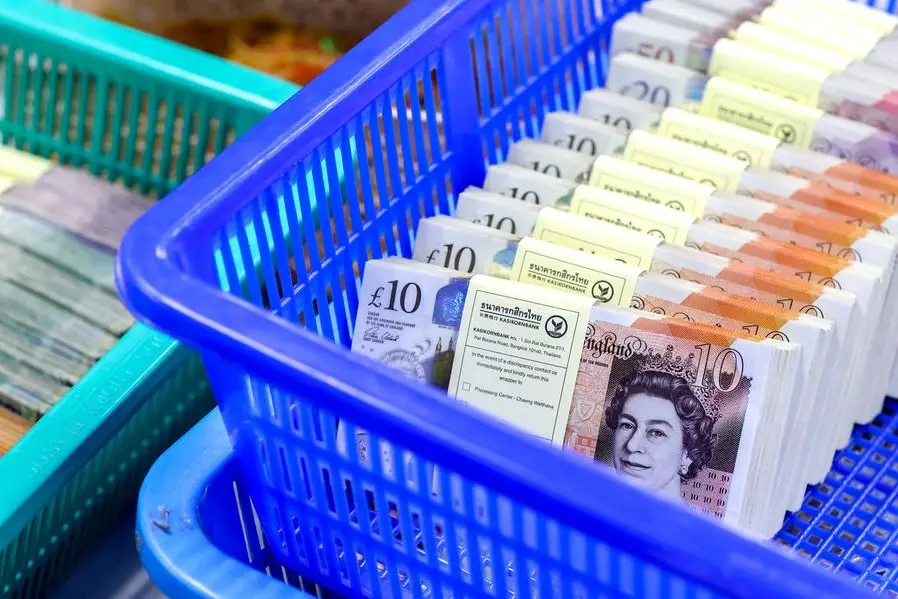PHOTO
LONDON - Fears that Britain could again become an inflation outlier among western economies should alarm sterling and UK assets - but their relative calm since this week's consumer price surprise suggests some benefit of the doubt is being offered.
The UK was the only country in western Europe still with double-digit inflation in March after the annual rate of consumer price increases fell far less than expected to 10.1% - and remains more the twice the U.S. equivalent.
Interest rate markets raced to price another Bank of England hike in this cycle, pushing the so-called "terminal rate" up another quarter point this week toward 5% - just shy of where futures markets see the U.S. Federal Reserve top out and more than point higher than the assumed European Central Bank peak.
Long-term gilt yields surged to begin with, but then reversed all of those moves within 24 hours. Domestic-facing UK stock indices were relatively calm.
Strikingly, the pound - so often the price to first reflect any new UK risk premium - was pretty quiet, barely budging against the dollar and euro.
Part of the apparent insouciance is an assumption that British inflation, for all that it remained surprisingly dogged last month, is just lagging other regions due to a peculiar reliance on natural gas prices that should reverse in April - and in part due to the way government handled energy subsidies last year.
If it is just a lagged statistical quirk, then the huge disparity in March inflation rates - of some 3-5 percentage points with western peers - should narrow sharply by yearend.
The International Monetary Fund only last week forecast UK inflation to end the year just above 4% - closing the gap with U.S. inflation to just over a point and within half a point of the expected December rate in the euro zone.
And for sterling, whatever wobble it might have assumed from the sticky inflation readout, seems to have been quickly neutralised by the rising BOE rate horizon.
With UK government fiscal policy considered to be back on more solid footing and the BOE having rebuilt some considerable credibility since, there was no echo of last September's chaotic budget farce that saw the pound and gilts plunging in tandem.
There has been no obvious return of what was unkindly dubbed the "moron risk premium" of late last year.
And yet there remains a uncomfortable question about whether Britain - more vulnerable to higher interest rates due to variable mortgage rate exposure and still facing serial labour strikes over inflation-lagging pay settlements - has the ability or willingness to squeeze harder on inflation if necessary.
With an election due next year, that may prove a big factor in any re-convergence of inflation rates if the cost of that is a much deeper economic downturn that rest.
"The Bank of England will have little choice but to raise rates in early May, as the UK lags the U.S. and Eurozone in taming inflation," said Lewis Grant, senior global equities portfolio manager at Federated Hermes.
"The UK's inflation profile is now markedly different from that of the U.S. and the Eurozone, and we believe it faces a deeper and more sustained recession."
SEPARATED FROM THE PACK?
The question about Britain as an inflation outlier re-opens the age-old issue about just how that should be priced into sterling. And for UK assets more broadly, embedded high inflation relative to other countries merely undermines the competitiveness of domestic companies and acts a bigger drag on government coffers.
Excessive inflation is, almost by definition, a negative for any currency as it means less goods and services can be bought internally for the same unit or bank note.
But the external exchange rate is more dictated by the compensation offered to overseas investors via higher interest rates - but also the economy's ability to sustain those higher borrowing rates for long without cratering overall demand.
For traders, the rates gamble usually pays off in the short term if you assume central banks are credible and independent enough to act tough on inflation now. But it is a different picture further out if the structure of the economy can't absorb such tightening.
BMO's global currency strategist Stephen Gallo reckons there's some hiatus in thinking right now as investors await more evidence that British disinflation will indeed play catch up in the next couple of months and traders assume the new BoE rate trajectory is deliverable for now.
But the stakes are high.
For much of the past 10 years, G7 inflation rates were largely locked together in either their subdued pre-pandemic state or during the wild price spikes since.
If UK inflation turns "idiosyncratic" among its peers during the much-vaunted normalization, then currency markets may need to rethink fundamental long-term assumptions about purchasing power, Gallo reckons.
"The current gap between UK wage and productivity growth is very wide — wide enough that it's probably a downside risk for the exchange rate," he told clients. "Equally, if it takes far longer for the UK to achieve positive real rates than its main trading partners, the result should be a weaker exchange rate."
The opinions expressed here are those of the author, a columnist for Reuters.
(by Mike Dolan, Twitter: @reutersMikeD. Charts by Bank of America, Vincent Flasseur and Lewis Krauskopf; Editing by Marguerita Choy)





















